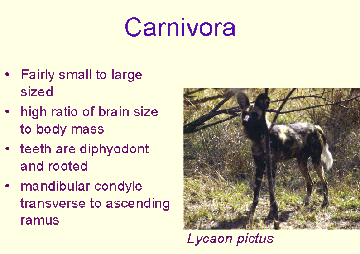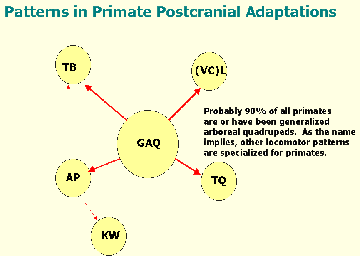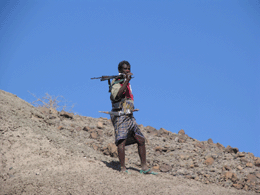Teaching
ASM
104 -- Bones, Stones, and Human Evoution
This
course is an introduction to the key concepts and discoveries in human
evolutionary biology. The focus is on evolution, ecology, and anatomical
adaptation and variation in the Order Primates, with particular emphasis
on humans. Major sections of the class are devoted to living primates
and their behavioral ecology, human and primate anatomy, genetics
and the mechanisms of evolution, primate and human evolution, and
adaptation and variation in modern human populations.
Practical
results of taking this course may include the ability to:
1) evaluate arguments about teaching evolution
2)
understand that humans have adapted to their environments and alter
their environments in ways that may be detrimental to their own survival
and that of other species
3) support the conservation of living apes and monkeys
4) understand the causes of genetic and endemic diseases
5) make reasoned judgments about claims regarding fossil evidence
and causes of biological selection, adaptation, and variation.
This
course meets the University General Studies requirements for Natural
Sciences (SG).
ASM
394 -- Fossil Primates
This
course is an overview of primate evolution from the Eocene through
the Plio-Pleistocene in an ecological context. To be able to understand
the evolutionary overview we first cover macroevolution, systematics,
primate skeletal morphology, primate ecology, and extant
primates. The first part of the class covers the background material
and the second part explores the various radiations of primates in
the past, both ecologically and phylogenetically. There is a lab component
to this class in which students examine skeletal material of both
extant and extinct primates.
extant
primates. The first part of the class covers the background material
and the second part explores the various radiations of primates in
the past, both ecologically and phylogenetically. There is a lab component
to this class in which students examine skeletal material of both
extant and extinct primates.
TEXT:
John
G. Fleagle. 1999. Primate Adaptation and Evolution. 2nd Edition.
REQUIREMENTS:
Three
exams and one short research paper. The paper is usually on the fossil
primate of the student's choice. Students are also expected to contribute
to class discussions.
ASM
598 -- Zooarchaeology and Paleoecology I
This
class focuses on theory and methodology of paleoecology as it relates
to  hominin
and primate evolution. Topics covered include: evolutionary paleoecology,
biogeography, community ecology, vegetation & climate, mammals
as habitat indicators, ecological diversity analyses, functional morphology,
species diversity, etc.
hominin
and primate evolution. Topics covered include: evolutionary paleoecology,
biogeography, community ecology, vegetation & climate, mammals
as habitat indicators, ecological diversity analyses, functional morphology,
species diversity, etc.
Zooarchaeology
and Paleoecology II is taught by Dr. Curtis Marean.
TEXT:
There
is no assigned textbook, but students need a book on mammals of a
particular region. Some of these may be available at the library,
in my office, or other sources.
REQUIREMENTS:
Bone
quizes, midterm and final presentation.
ASM
591 -- Primate Paleobiology
This
course covers all non-hominin evolution from the Paleocene through
the Pleistocene. The class also provides a background in the theory
and methodology of primate evolution including macroevolution, speciation,
systematics, cladistics, skull and skeletal morphology, and geology/paleontology.
An intensive review of extant primate diversity is also covered.
through
the Pleistocene. The class also provides a background in the theory
and methodology of primate evolution including macroevolution, speciation,
systematics, cladistics, skull and skeletal morphology, and geology/paleontology.
An intensive review of extant primate diversity is also covered.
TEXT:
John
G. Fleagle. 1999. Primate Adaptation and Evolution. 2nd Edition.
REQUIREMENTS:
Two
exams, one group project, and one research paper. The research paper
is presented orally in the form of a typical conference paper and
written up in either American Journal of Physical Anthropology or
Journal of Human Evolution format. Students must also contribute to
class discussions.
ASM
591 -- Ecology and Human Evolution
This
class focuses on the inter-relationship of ecology and evolution in
the various lineages of our own family.
REQUIREMENTS:
There are reading assignments for each class period for which students
must supply at least one question, all of which become the basis for
discussion. Rather than writing a paper, graduate students write a
proposal for a research project to apply to granting agencies such
as the Leakey Foundation or the National Science Foundation. The final
length and format of the proposal depends on how much money is needed.
Hadar
Paleoanthropology Field School
The
School of Human Evolution, the Institute of Human Origins and the
International Programs Office offer a field school opportunity in
paleoanthropology at the Hadar hominin site in Ethiopia. The program
includes instruction in paleoecology, faunal analysis, hominid evolution,
geology and archaeology.

The
field school is directed by Dr.
William Kimbel (ASU) and myself. For more information visit the
Hadar Paleoanthropology
Web Site.
